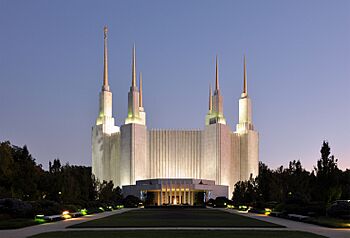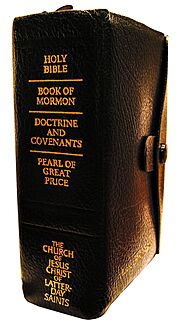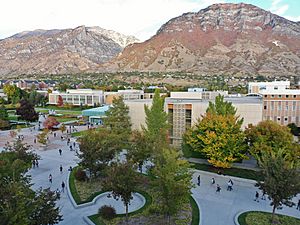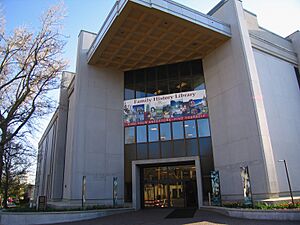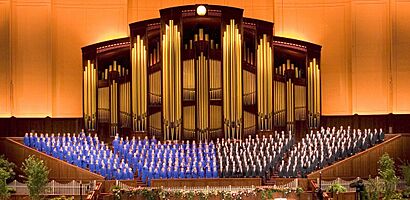The Church of Jesus Christ of Latter-day Saints facts for kids
Quick facts for kids The Church of Jesus Christ of Latter-day Saints |
|
|---|---|
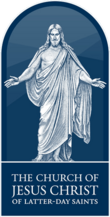
The church's official logo, featuring a statue of Jesus Christ called the Christus.
|
|
| Classification | Restorationist |
| Orientation | Latter Day Saint movement |
| Scripture |
|
| Theology |
|
| Polity | Hierarchical |
| President | Russell M. Nelson |
| Region | Worldwide |
| Headquarters | Salt Lake City, Utah, U.S. |
| Founder | Joseph Smith |
| Origin | April 6, 1830 (as Church of Christ) Fayette, New York, U.S. |
| Separations | LDS denominations |
| Congregations | 31,676 (2024) |
| Members | 17,509,781 (2024) |
| Missionaries | 109,439 (2024) |
| Aid organization | Philanthropies |
| Tertiary institutions | 4 |
| Other name(s) |
|
The Church of Jesus Christ of Latter-day Saints, often called the LDS Church or Mormon Church, is a Christian faith that was started in the United States. Members of the church are called Latter-day Saints. They believe that their church is the same church that Jesus Christ originally organized when he was on the Earth.
The church was founded by Joseph Smith in 1830. Its main headquarters is in Salt Lake City, Utah. Today, the church has congregations and temples all over the world. As of 2024, there are over 17.5 million members and more than 109,000 volunteer missionaries.
Latter-day Saints believe in God the Father, his son Jesus Christ, and the Holy Ghost. They believe that Jesus Christ is the Savior of the world. The church has four main books of scripture: the Bible, the Book of Mormon, the Doctrine and Covenants, and the Pearl of Great Price.
Members follow certain health rules, such as not drinking alcohol or coffee. They also give ten percent of their income to the church, which is called tithing. Family is very important, and members believe families can be together forever through special ceremonies in temples.
Contents
The Story of the Church
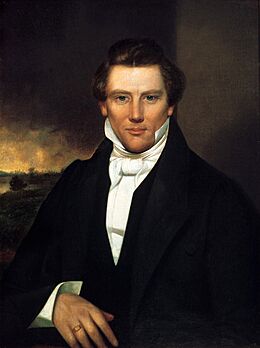
How the Church Began
The church's history began in the 1820s with a young man named Joseph Smith. He said that God the Father and Jesus Christ appeared to him in a vision. They told him that he would be the one to bring back, or "restore," the original church of Jesus Christ to the earth.
Latter-day Saints believe that Joseph Smith was guided to a set of buried golden plates. They believe he translated the writing on these plates into the Book of Mormon. This book tells the story of ancient people who lived in the Americas and were visited by Jesus Christ after his resurrection.
Joseph Smith officially organized the church on April 6, 1830, in New York. As the church grew, its members moved to different places to build communities. They moved from New York to Ohio, then to Missouri, and later built a large city called Nauvoo in Illinois.
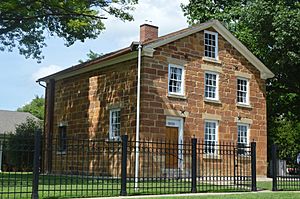
The early members of the church faced a lot of opposition. In 1844, Joseph Smith and his brother Hyrum were killed by a mob. After their deaths, the church had to choose a new leader. Most members chose to follow Brigham Young, who was the senior apostle at the time.
Some smaller groups chose different leaders and are not part of The Church of Jesus Christ of Latter-day Saints today. The largest of these other groups is the Community of Christ.
The Journey to the West
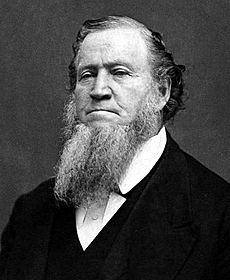
After Joseph Smith's death, the conflicts in Illinois continued. In 1846, Brigham Young led the members, known as the Mormon pioneers, on a long journey west. They traveled across the plains to the Salt Lake Valley in what is now the state of Utah.
They settled in this dry region and worked hard to build communities. They built Salt Lake City and the famous Salt Lake Temple. Over many years, Latter-day Saints settled a large area of the American West.
During the 19th century, some early church members practiced plural marriage, where a man was married to more than one woman. This caused conflict with the U.S. government. The church officially ended this practice in 1890.
The pioneers' arrival in the West also led to conflicts with the U.S. government and with Native American tribes whose lands the settlers moved into.

The Church in Modern Times
In the 20th century, the church grew from a small faith in the American West into a worldwide organization. Temples have been built on every inhabited continent.
The church has made some important changes over the years. In 1978, the church president announced that all worthy male members of any race could be ordained to the priesthood.
Today, the church is known for its focus on families and for its large humanitarian aid program, which helps people in need all over the world.
What Latter-day Saints Believe

The Godhead
Latter-day Saints believe in God the Father, his son Jesus Christ, and the Holy Ghost. They teach that these are three separate beings who are perfectly united in their purpose. This is different from the traditional Christian belief in the Trinity, which sees God as one being in three persons. They also believe that God the Father and Jesus Christ have physical bodies of flesh and bone.
The church also teaches that all people are spirit children of a Heavenly Mother and a Heavenly Father.
Jesus Christ and the Plan of Salvation
Members of the church believe that Jesus Christ is the Son of God and the Savior of the world. They believe that through his life and sacrifice, everyone can be saved and return to live with God.
This is part of what they call the "plan of salvation." They believe that all people lived with God as spirits before they were born. They came to Earth to gain experience and learn to make good choices. After death, they believe everyone will be resurrected and can return to God's presence, where families can be together forever.
Restoring the Original Church
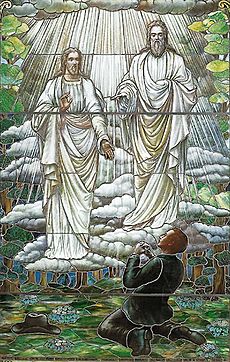
A core belief of the church is that after the original apostles of Jesus died, the true church and its authority were lost from the Earth. This is called the Great Apostasy.
Latter-day Saints believe that Joseph Smith was chosen by God to be a modern-day prophet to "restore" the original church that Jesus established. This is why the church is known as a restorationist faith.
Prophets and Scripture
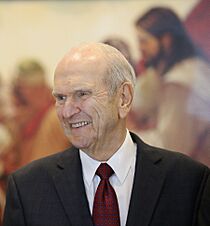
Latter-day Saints believe that God continues to lead the church today through living prophets and apostles, just as he did in biblical times. The president of the church is considered a prophet, and he leads the church with two counselors and a group of twelve apostles.
The church has four main books of scripture, which are called the "standard works":
- The Bible (both the Old and New Testaments).
- The Book of Mormon, which they believe is another testament of Jesus Christ.
- The Doctrine and Covenants, which is a collection of revelations given to modern prophets.
- The Pearl of Great Price, which contains other writings of Joseph Smith and ancient prophets.
Living the Faith
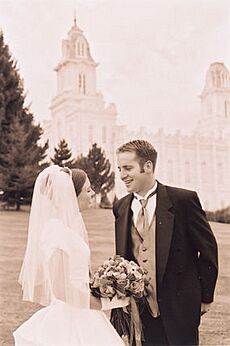
Worship and Meetings

Each Sunday, members gather for worship services in buildings called meetinghouses. The main meeting is called "sacrament meeting." During this service, members sing hymns, pray, and listen to talks given by other members. They also take the sacrament (similar to communion) to remember Jesus Christ.
After sacrament meeting, there are other classes, like Sunday School for learning about the scriptures. Local congregations are called wards, and a group of wards is called a stake.
Twice a year, in April and October, the church holds a general conference. The leaders of the church give talks that are broadcast to members all over the world.
Temples

Temples are the most sacred buildings for Latter-day Saints. They are considered "Houses of the Lord." Inside temples, members make special promises to God and take part in sacred ceremonies. One of these ceremonies is sealing, where a husband and wife are married for eternity, not just "until death do you part." Children can also be sealed to their parents so their family can be together forever.
After a temple is dedicated, only members of the church who are living the church's standards can enter.
Missionary Work
The church is well known for its missionary program. Many young men serve as full-time missionaries for two years, and many young women serve for 18 months. They are sent to places all over the world to teach people about Jesus Christ and the restored gospel. Older couples can also serve missions.
Rules for Living
Latter-day Saints follow a code of health called the Word of Wisdom. This means they do not drink alcohol, coffee, or tea, and they do not use tobacco. The Word of Wisdom also encourages eating healthy foods.
Members are also asked to pay tithing, which is a donation of ten percent of their income to the church. This money is used to build churches and temples, run church programs, and help with humanitarian work.
Family is very important in the church. Members are encouraged to hold a "Family Home Evening" once a week, where they spend time together learning, playing games, and strengthening their family bonds.
The Church Around the World
A Global Community
Today, The Church of Jesus Christ of Latter-day Saints is a global faith. There are more than 17 million members, and more than half of them live outside of the United States. The church is growing especially fast in Latin America, Africa, and the Philippines.
The church has a diverse membership, with people from many different countries and cultures. Church materials, including the scriptures, are translated into over 100 languages.
Helping Others
The church runs a large humanitarian program called LDS Humanitarian Services. It provides help to people in need around the world, regardless of their religion. The church is often one of the first groups to send aid after natural disasters like earthquakes, hurricanes, and floods.
The church also works on long-term projects to help communities. These projects include providing clean water, giving wheelchairs to people who need them, and teaching skills to help people find jobs.
Education and Family History
The church places a high value on education. It runs several universities and colleges, including Brigham Young University (BYU) in Utah, Idaho, and Hawaii. It also has religious education programs for high school and college students.
Because of the belief that families can be together forever, learning about ancestors is very important. The church runs FamilySearch, the largest genealogical organization in the world. It provides free access to billions of historical records so people can discover their family history.
See also
 In Spanish: La Iglesia de Jesucristo de los Santos de los Últimos Días para niños
In Spanish: La Iglesia de Jesucristo de los Santos de los Últimos Días para niños
- Index of articles related to the Church of Jesus Christ of Latter-day Saints
- List of temples of the Church of Jesus Christ of Latter-day Saints
- List of missions of the Church of Jesus Christ of Latter-day Saints
- Christianity in the United States
- Anti-Mormonism
- List of attacks against Latter-day Saint churches
- Mormon (word)
- Mormonism and Islam
- Mormonism and Judaism
- List of new religious movements


